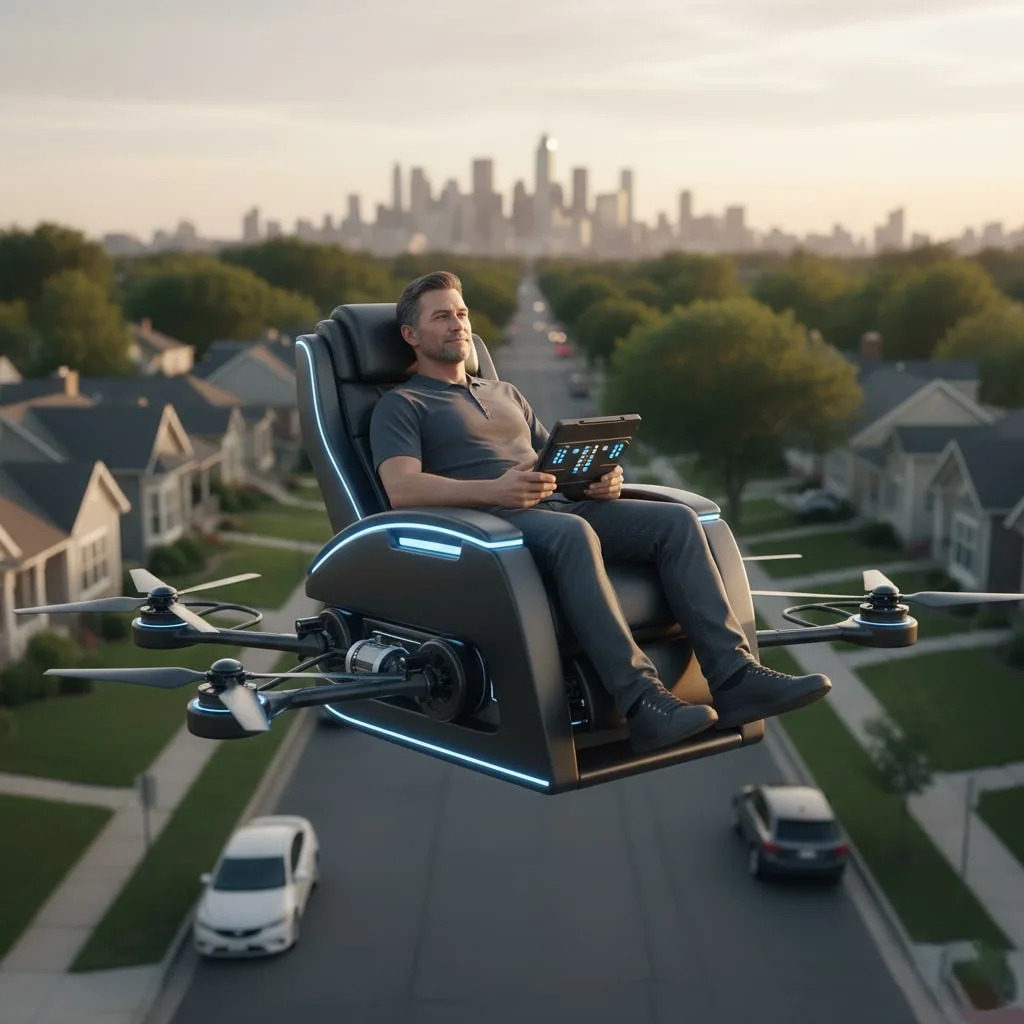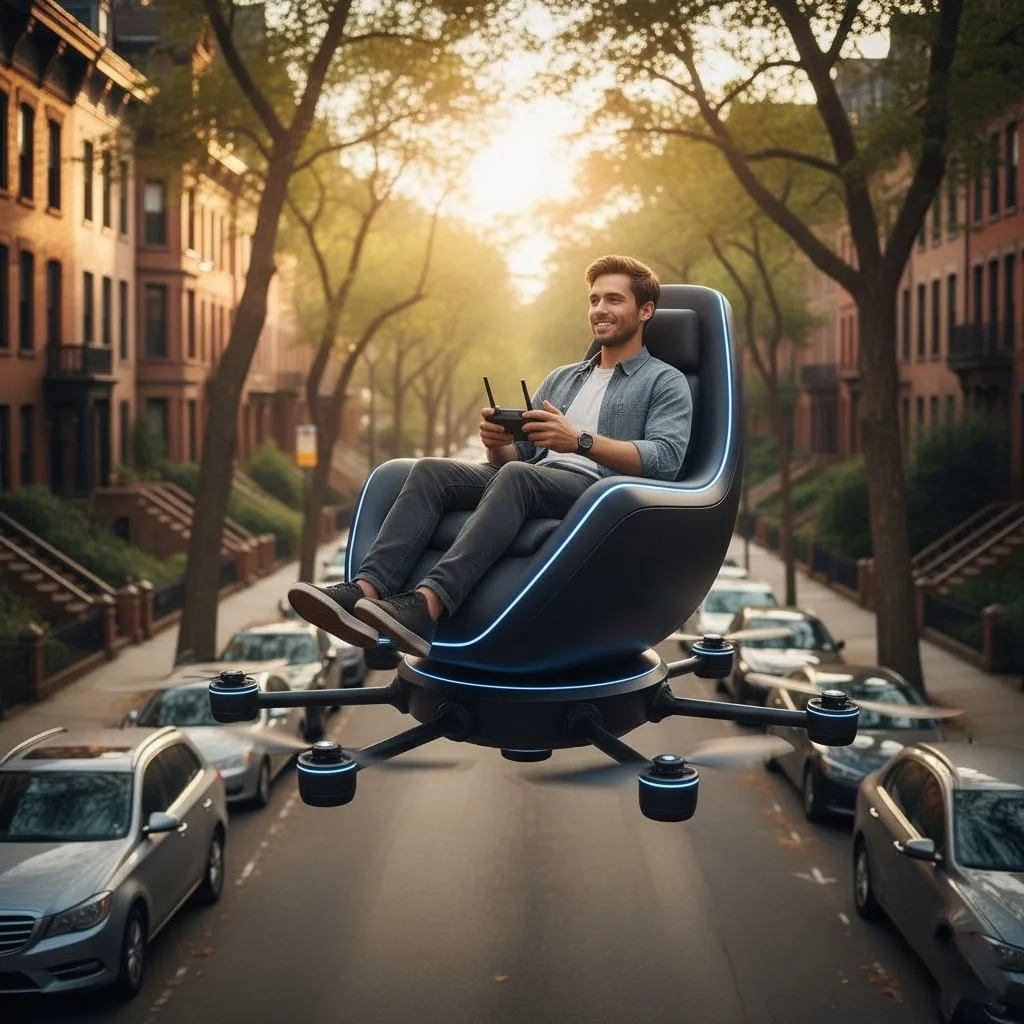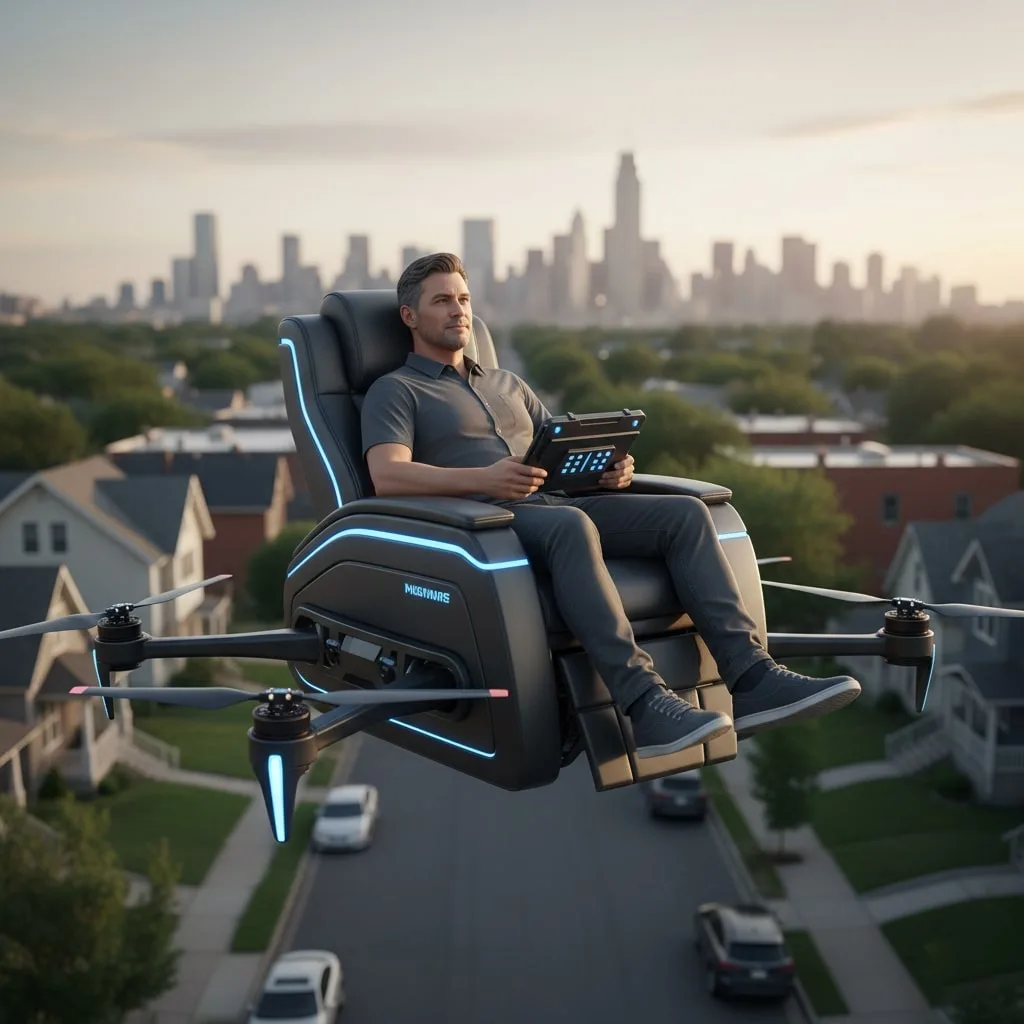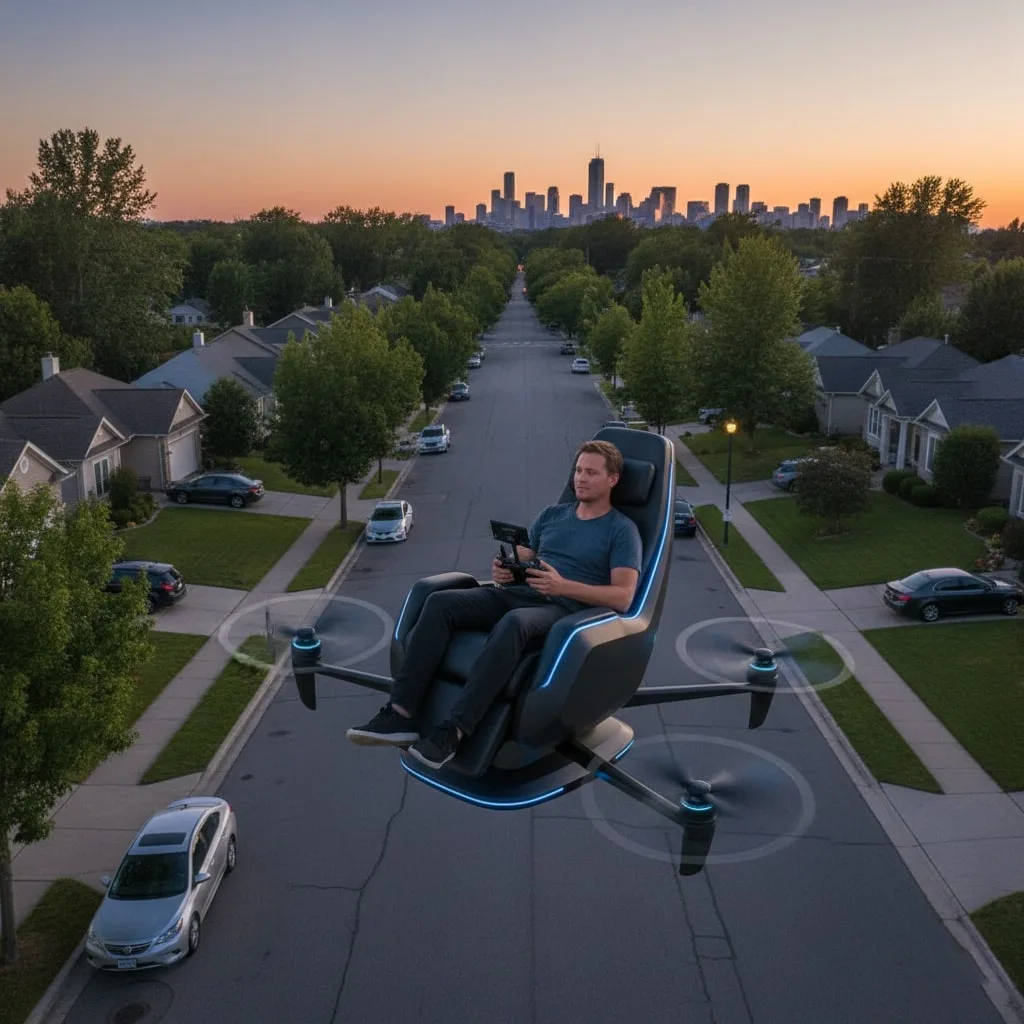The concept of a recliner drone sounds like something straight out of a science fiction movie, yet this innovative technology is rapidly becoming a reality in our modern world. Imagine sitting comfortably in your favorite recliner while soaring through the sky, controlling your flight path with simple hand gestures or voice commands. This isn’t just fantasy anymore – engineers and aviation enthusiasts worldwide are working diligently to make personal aerial vehicles accessible to everyone, and the recliner drone represents one of the most comfortable approaches to this futuristic vision.
What Exactly Is a Recliner Drone?

A recliner drone combines the comfort of a traditional reclining chair with advanced drone technology to create a personal aerial vehicle. Unlike conventional drones that carry cameras or packages, these innovative machines are designed to transport a human passenger in a seated, relaxed position. The fundamental design incorporates multiple high powered rotors, sophisticated stabilization systems, and intuitive controls that allow the pilot to navigate through the air while enjoying the ergonomic support of a quality recliner.
The engineering behind these flying chairs represents a significant leap forward in personal aviation technology. These vehicles typically feature six to eight rotors arranged around a central seating platform, providing redundancy and stability during flight. The recliner itself is specially designed with lightweight materials that don’t compromise on comfort, ensuring that passengers can enjoy extended flight times without fatigue.
The Technology Behind Flying Recliners

Advanced Propulsion Systems
The propulsion system of a recliner drone relies on multiple electric motors driving carbon fiber propellers. This multi rotor configuration provides several advantages over traditional helicopter designs. First, the distributed power system means that if one motor fails, the remaining motors can compensate and allow for a controlled descent. Second, electric motors are quieter and more environmentally friendly than combustion engines, making these vehicles suitable for use in residential areas.
Modern recliner drones utilize brushless DC motors known for their efficiency and reliability. These motors can adjust their speed thousands of times per second, responding to input from the flight controller to maintain stable flight even in challenging conditions. The total thrust generated by these motors must exceed the combined weight of the vehicle and passenger by a significant margin, typically around 150 to 200 percent, to ensure safe operation and adequate maneuverability.
Intelligent Flight Control Systems
The brain of any recliner drone is its flight controller, a sophisticated computer system that processes data from multiple sensors to maintain stable flight. Accelerometers measure the vehicle’s acceleration in three dimensions, gyroscopes track rotational movement, and magnetometers provide compass heading information. GPS receivers enable precise positioning and can facilitate autonomous navigation to predetermined destinations.
Advanced recliner drones also incorporate barometric pressure sensors to maintain altitude, ultrasonic or lidar sensors to detect obstacles, and even artificial intelligence systems that can predict and respond to changing flight conditions. These systems work together seamlessly to ensure that even novice pilots can operate the vehicle safely, with the computer handling the complex calculations required to keep the recliner level and stable.
Safety Features and Considerations

Built In Redundancy
Safety is paramount when designing any human carrying aircraft, and recliner drones incorporate multiple layers of redundancy to protect passengers. Beyond the multiple motor configuration mentioned earlier, these vehicles often feature dual flight controllers that can take over if the primary system fails. Battery systems are also typically redundant, with multiple battery packs that can independently power the motors.
Many designs include emergency parachute systems that can deploy automatically if the vehicle experiences a catastrophic failure. These parachutes are designed to bring the entire recliner drone safely to the ground, protecting the passenger even in worst case scenarios. Some advanced models also feature airbag systems similar to those found in automobiles, providing additional protection during landing.
Regulatory Compliance and Pilot Training
Operating a recliner drone isn’t as simple as sitting down and taking off. Aviation authorities around the world are developing regulations specifically for personal aerial vehicles, and pilots will likely need to obtain special licenses or certifications before flying these machines. Training programs are being established to teach operators about flight principles, weather considerations, emergency procedures, and navigation rules.
Current regulations in many countries limit recreational drones to certain altitude ranges and prohibit flight over populated areas without special permission. As recliner drone technology matures, we can expect more comprehensive regulatory frameworks that balance innovation with public safety. Prospective pilots should stay informed about local aviation laws and be prepared to complete required training before taking to the skies.
Practical Applications and Use Cases

Recreational Flying and Tourism
The most obvious application for recliner drones is recreational flying. Imagine spending a weekend afternoon gently cruising over scenic landscapes, enjoying aerial views that were previously accessible only to helicopter passengers or pilots. Tourism companies are already exploring the potential of offering guided aerial tours using these vehicles, allowing visitors to experience destinations from entirely new perspectives.
Adventure parks and experience centers could incorporate recliner drones into their attractions, offering supervised flights over designated areas. This would democratize the flying experience, making it accessible to people who might never have the opportunity to pilot traditional aircraft. The comfortable seating position also makes these vehicles ideal for longer flights, enabling aerial sightseeing trips that last an hour or more.
Personal Transportation Solutions
In the future, recliner drones could serve as personal transportation devices for short to medium distance travel. Instead of sitting in traffic on congested highways, commuters could fly directly to their destinations, dramatically reducing travel time. This vision aligns with the broader concept of urban air mobility, where cities incorporate three dimensional transportation networks to alleviate ground level congestion.
Real estate developers are already considering how to integrate landing pads and charging stations into building designs to accommodate personal aerial vehicles. Parking garages might eventually include designated areas for recliner drones, complete with security systems and weather protection. As battery technology improves and flight times increase, these vehicles could become practical alternatives to traditional automobiles for daily commuting.
Accessibility and Mobility Assistance
Recliner drones offer unique possibilities for people with mobility challenges. The comfortable seated position eliminates the need to climb stairs or navigate difficult terrain, potentially giving individuals with disabilities unprecedented freedom of movement. Specialized medical versions could transport patients between facilities or provide emergency medical services in areas with limited ground access.
The technology could be particularly valuable in rural or remote locations where traditional transportation infrastructure is limited. Residents of isolated communities could use recliner drones to access services, visit family members, or respond to emergencies without relying on lengthy ground travel. This application could significantly improve quality of life for millions of people worldwide.
Current Market Leaders and Innovations

Pioneering Companies and Designs
Several companies have emerged as leaders in the personal aerial vehicle space, each bringing unique approaches to the recliner drone concept. Some focus on lightweight recreational designs optimized for short flights and easy operation, while others develop heavier duty vehicles capable of longer range travel and higher payload capacities. These companies are pushing the boundaries of what’s possible with current technology while working closely with regulators to establish safety standards.
Prototype demonstrations have shown impressive capabilities, with some recliner drones achieving flight times exceeding 30 minutes and reaching speeds over 60 miles per hour. These demonstrations generate tremendous public interest and help drive investment in the sector. As competition increases, we’re seeing rapid improvements in battery efficiency, motor power, and overall vehicle design.
Customization and Personalization Options
Just as automobile manufacturers offer various trim levels and customization options, recliner drone makers are beginning to provide personalized features. Customers can choose from different seating materials, color schemes, and integrated technology packages. Some high end models include features like built in entertainment systems, climate control, and even beverage holders for the ultimate in aerial luxury.
Advanced buyers can opt for performance upgrades such as more powerful motors, extended range battery packs, and enhanced navigation systems. The modular nature of many designs allows for future upgrades as technology improves, protecting the investment and ensuring that vehicles don’t become obsolete as the industry evolves.
Challenges Facing Recliner Drone Adoption

Battery Technology Limitations
The single biggest obstacle to widespread recliner drone adoption is battery technology. Current lithium polymer and lithium ion batteries provide limited energy density, restricting flight times and requiring lengthy recharging periods. Engineers are working on next generation battery systems including solid state batteries and hydrogen fuel cells that promise significantly improved performance.
Weight is also a critical factor, as batteries represent a substantial portion of the vehicle’s total mass. Every pound dedicated to batteries is a pound that cannot be used for payload or structural components. Researchers are exploring ways to integrate batteries into the vehicle’s frame, using structural battery concepts that serve both mechanical and energy storage functions.
Public Perception and Acceptance
Gaining public acceptance for recliner drones will require addressing concerns about safety, noise, privacy, and environmental impact. Many people are understandably hesitant about the idea of numerous flying vehicles operating above their homes and neighborhoods. Manufacturers must demonstrate impeccable safety records and work with communities to address these legitimate concerns.
Education campaigns highlighting the benefits of personal aerial vehicles while honestly discussing risks and mitigation strategies will be essential. Public demonstrations and trial programs can help familiarize people with the technology and build trust. As successful operations accumulate and safety records prove robust, public acceptance is likely to grow.
The Environmental Impact Perspective

Emissions and Sustainability
Electric recliner drones produce zero direct emissions during operation, making them environmentally friendlier than gasoline powered vehicles for short trips. However, the overall environmental impact depends on how the electricity used to charge their batteries is generated. When powered by renewable energy sources like solar or wind, these vehicles represent a genuinely sustainable transportation option.
The manufacturing process for batteries and electronic components does have environmental costs that must be considered. Responsible manufacturers are working to minimize their ecological footprint through careful supply chain management, recycling programs, and sustainable production practices. As the industry matures, we can expect increasing emphasis on lifecycle environmental impact assessment.
Noise Pollution Considerations
While electric motors are quieter than combustion engines, recliner drones do generate noise from their propellers cutting through the air. This aerodynamic noise can be significant, particularly for high speed operations. Engineers are developing quieter propeller designs and exploring ways to reduce the acoustic signature of these vehicles without sacrificing performance.
Operational guidelines will likely restrict flight paths and altitudes to minimize noise impact on residential areas. Just as airports have noise abatement procedures, recliner drone operators may need to follow designated routes and respect quiet hours. Advanced designs might incorporate active noise cancellation technology or variable pitch propellers that optimize for quiet operation during certain flight phases.
Wrapping Up the Sky High Revolution
The recliner drone represents an exciting convergence of comfort, technology, and personal freedom that could fundamentally change how we think about transportation and recreation. While significant challenges remain before these vehicles become commonplace, the rapid pace of technological advancement suggests that flying recliners may become a regular sight in our skies sooner than many expect. From recreational weekend flights to practical commuting solutions, the applications are limited only by our imagination and regulatory frameworks.
As battery technology improves, safety systems become more sophisticated, and public acceptance grows, the dream of personal aerial vehicles will increasingly become reality. The recliner drone embodies this vision in its most comfortable and accessible form, promising to give ordinary people the extraordinary experience of flight. Whether you’re an early adopter eager to be among the first to take to the skies or a cautious observer watching developments from the ground, there’s no denying that recliner drones represent a fascinating glimpse into our aerial future. The sky is no longer the limit but rather the beginning of a new frontier in personal mobility and adventure.

